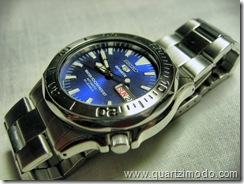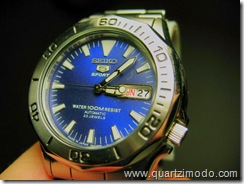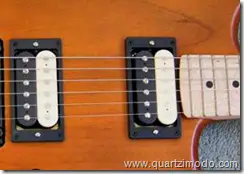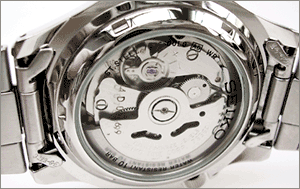Automatics need a workout too!
I’ve owned this nice midsized Seiko 5 Sports for the past five years. It’s a Seiko 5 Sports “Seamaster", model SNZ389J which also happens to be the first watch that I purchased from eBay. Ever since I got into my fad for larger sized watches, I found myself neglecting the SNZ389J too often. In fact, I can’t even remember the last time I wore this watch but suffice to say it could have been at least two years ago.
A week ago I opened my watch drawer and remembered my nice blue dialed SNZ389J hibernating in its box. Since the watch is rather small, it shares a watch pillow with my Seiko 5 SNKE01K, which is an equally compact timepiece.
Without thinking I shook the watch to get it running, set the calendar and time and wore it. An hour later I glanced at my watch and I was surprised that it lost about 30 minutes. Uh-oh…that could spell trouble. 🙁
I reset the Seiko Seamaster to the current time and hoped that it was a fluke incident. After all, the movement had not been wound for quite some time. I also have several vintage Seiko watches, some dating to the year 1969 which I also rarely wear but all of them started and ran perfectly from a totally unwound state.
Half an hour later I looked at my SNZ389J and found that it was rapidly losing time. Fortunately the watch was equipped with the glass display back (thank goodness for that!) and I visually inspected the escapement, which is that tiny concentric spring that oscillates back and forth, serving as the watch’s timekeeping.
Above: Early photos of my Seiko 5 Sports, model SNZ389J
To my horror, the escapement was oscillating a lot slower than it’s supposed to. It was like in its death throes, painfully swinging back and forth with difficulty. I noticed my watch’s second hand swept across the dial smoothly though, which was kind of strange. Now for the aural test. I put my ear to the watch to listen to the escapement’s beat and the sound was faint.
I vigorously shook the watch for several minutes, hoping to clear the problem. The Seamaster still lost time, as much as eight minutes to the hour. This was totally unacceptable to me and I tried to fathom what could have happened to my watch. As with all my watches, I’ve never subjected it to hard shocks, let alone dropping them accidentally.
Magnetic effects on a mechanical watch
Could it have been a case of my beloved Seamaster being magnetized over time?
That could be a possibility but I ruled it out as there are no sources of magnetism in the drawer where I store my watches. I’ve always been careful not to place my watches near strong magnetic field sources such as computer speakers on my desk or let them anywhere near the pickups of my electric guitars or basses, which have very powerful magnets.
Other sources of magnetic fields include the earpiece of some cellphones and cathode ray tube (CRT) television sets and computer monitors.
I’m right-handed and I’ve long stopped the habit of wearing my watches on my right wrist. Strapping a watch on my right wrist will simply impair my playing, not to mention risking the watch bracelet to scratches from the guitar or bass strings.
You may have noticed that guitarists and bass players rarely wear timepieces when performing onstage and even if they do, they would wear their watches on their fretting wrist.
Above: Dual coiled pickups for electric guitars and basses yield very high magnetic fields. It’s inadvisable not to let mechanical watches anywhere near them if you play these musical instruments. (Borrowed image)
A magnetized main spring in a mechanical watch can result in erratic timekeeping and the only recourse is to have it demagnetized by a watchmaker with degaussing equipment. More expensive Seiko models have better anti-magnetic properties, usually in the region of 4,800 Gauss or better.
Which leaves two other possibilities:the Seamaster’s main spring being tangled up (the main spring isn’t visible through the glass display back) or a problem with the escapement itself. I didn’t relish the thought of having my Seiko 5 Sports sent for servicing as the cost would put a dent in my wallet. The watch itself cost me around USD90 and a routine service by my watchmaker would set me back almost USD35.
Top: A simulated animation of the escapement seen via the glass caseback (borrowed image)
Now, thirty five bucks may sound dirt cheap to you, but the cost of servicing constitutes nearly 39% of the cost of the watch. If it happened to one of my USD450 Seikos, the proportion would be just 7.8% so at least that would be somewhat justifiable. The thought of having to drive across town to the Seiko service center wasn’t something I relish as ample parking at Plaza Central is virtually impossible to find and bumper-to-bumper traffic in the heart of the city is legendary.
My SNZ389J isn’t really one of my favorite watches but it remains one of my sentimental watches. It happens to be Seiko’s homage to the Omega Seamaster diver and it’s also a discontinued model. Although I seldom wear it, it’s one of the permanent residents in my watch drawer.
Lessons that were learned
Rather than to accept the fate of my watch and place it back in the drawer, I decided to wear the Seiko for the rest of the day, making sure that I shake the watch on my wrist every ten minutes. What do you know – after several hours, to my delight my Seiko Seamaster was ticking away happily, just like when I first received it. 🙂
The watch gained about 20 seconds throughout the day (most new 7s-caliber Seikos run fast out of the box) and to be sure, I continued wearing it over a three day period. Success! My watch finally recovered from its deep slumber and I’m quite relieved that I don’t have to spend a dime on repairs, which would probably be totally unnecessary.
So, what could have happened to my SNZ389J? My best guess is that the lubricating oils may have temporarily congealed over time as a result of long term non-wearing. I’m somewhat surprised that it happened to a 7s36A movement (which all modern Seiko 5 Sports models use) and the watch has yet to reach its 10th birthday. I took things for granted, assuming that my watch would pose no problems whatsoever despite the long term neglect.
Although mechanical watches are often recommended for a routine lubrication maintenance every six years, many owners of vintage Seiko timepieces have attested that their watches have been running for decades without major problems with no service intervals. The 7s calibers are truly low cost watch movements that Seiko has ever made and if broken, it may be cheaper to buy a replacement unit rather than spending on repair fees.
Seiko watches are renowned for their robustness, longevity and ease of maintenance when required. In the world of automobiles, I guess Seiko could be compared to the vintage Volvo cars from the 1970s (many are still plying well on roads across the world) and in the arena of firearms, perhaps Seiko is as reliable and long lived as the legendary Soviet-made, Kalashnikov AK-47 7.62mm assault rifle. Volvo cars are virtually built to last a lifetime while AK-47 rifles, despite cheaply manufactured can take a lot of abuse in combat, needing very minimal maintenance in the field.
(No, I actually don’t like real guns, except in computer simulation games like Rainbow Six) 🙂
Above: Two recognizable international icons representing reliability, robustness and longevity like Seiko watches: The Volvo 240 and the well known, AK-47 assault rifle. Images from the Internet.
I guess I’ve truly learned my lesson now – not to take any of my automatic watches for granted! Despite the 7s caliber’s renowned toughness and resilience, automatics still need to be worn once in a while to reduce the likelihood of the movement’s oils and lubricants from gelling up. And like the pumping heart in your body, mechanical watches need exercise too! 🙂
Did you enjoy this post? Why not leave a comment below and continue the conversation, or subscribe to my feed and get articles like this delivered automatically to your feed reader.
Comments
Well, Wochomi….every guitarist has his or her personal preferences. Your friend is also doing his watch a favor by wearing it on his strumming hand – Kinetic watches need a lot of shaking to get them to full charge. 🙂 I think metal-to-metal contact isn’t a good thing. Not only the bracelet and clasp will get scratched in the process, the guitar strings can break more easily. Personally, a watch on my strumming hand gets in the way of my playing. Not cool!
Thanks for another great article. Love reading your pieces.
I have the complete opposite of your experience. My new Seiko 5 SNZE85K1 is running about 15 mins faster per day. Had it for about a week and its still that fast with no signs of slowing down. From the forums, it seems that Seiko 5s tend to run fast out of the box but I think this is way too much.
Any advice?
Hi Fungus,
Give a few months for your new watch to break in. Seiko 7s calibers are roughly regulated at the factory but should not run as fast as 15 mins/day. It’s a known fact that vigorously shaking the watch on your wrist will always speed up the movement. If your watch is still under warranty, take it to the Seiko service center and have it regulated. Also note that a one-time regulating procedure may not give you satisfactory results.
Mechanical watch regulating is usually done over several weeks to improve its accuracy. It may take thee or four trips to the watchmaker to get it right, depending on the temperament of the watch. Good luck! 🙂
Quartzimodo
Hello Quartzimodo,
A very nice informative study and lesson on the effects of non-use of automatic movements!
I guess the old saying applies: (If you don’t use it, you’ll lose it)
Time & regulation needs to be excercised every now and then for a stable running movement with the correct beats per hour give or take, just as a human heart beats to a standard acceptible variable rate and requires excercise to maintain it’s healthy state., so your study was well done and will be adhered to by many that have the good opportunity to read this great lesson to be learned.
Nice post and many thanks Quartzimodo-
Your friend and brother in WISdom,
Jimmy
New York/USA
Hi Quartzimodo,
I just bought Seiko 5 Atlas skz211 last saturday, but the watch delivered to my hometown. Which means the watch never been wear on hand or shake it for 5-6 days, will the watch stop moving? How’s ur atlas doing so far? Have you share any post on your experiences of maintenance in automatic watch? Cos this is my very 1st automatic watch.
Anthony
Hi Anthony,
Yes, of course your Atlas will wind down if you don’t wear it or shake the watch for a few minutes. Both my Atlas watches are doing fine although I haven’t worn them for quite a few months. The 7s36 movement is quite robust and can go on for at least 10 years if you wear the watch sparingly. If you intend to wear yours daily, have the movement lubricated and regulated once every 6 years. The more often you wear an automatic, the more the wear-and-tear on its components.
Quartzimodo
Hi Dany,
If you’re referring to Seiko mechanical watches, you can leave them in a total state of unwound for 6 months without any problems whatsoever. As years go by, the lubricants that coat the internal gears will coagulate or dry up. Have them checked for their winding performance and accuracy once in three years. Regulate your watches if they gain or lose time more than 60 seconds per day, which is well outside Seiko’s accuracy specs.
Quartzimodo
Hi Steve C,
A Seiko 5 Sports is an automatic, mechanical watch and not quartz. It doesn’t run on electricity and thus has no need for a battery or a capacitor. If your watch runs too fast or too slow, you’ll have to take it to an experienced watch repairman who knows how to regulate a mechanical watch properly.
Don’t confuse an automatic with the Seiko Kinetic technology as they are two different mechanisms altogether. 🙂
Quartzimodo








Have a friend who wears it on the hand doing the strumming, says that the weight of his ALba Kinetik gives him the stability. I guess it’s okay since his alba kinetik is a dynamo by design… then he found that the watch also helps support his sprained wrist… duh….